What is a DEX?
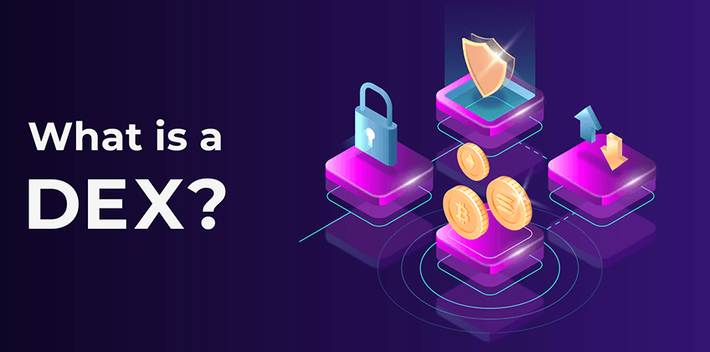
A decentralized exchange (DEX) is a peer-to-peer marketplace where cryptocurrency transactions occur directly between traders without the need for intermediaries like banks or brokers. DEXs enable users to engage in financial transactions that are not controlled or mediated by traditional institutions. They are a key component of the decentralized finance (DeFi) ecosystem, which provides various financial services directly from compatible crypto wallets.
DEXs like Uniswap and Sushiswap, which are built on the Ethereum Blockchain Development Company, have gained significant popularity. These platforms utilize smart contracts to facilitate secure and transparent transactions. By leveraging blockchain technology, DEXs offer advantages such as greater user control over funds, increased privacy, and the ability to trade a wide range of assets.
According to available data, DEXs witnessed remarkable growth in the first quarter of 2023, with approximately $217 billion in transactions flowing through decentralized exchanges. This highlights the increasing adoption and usage of DEXs. Furthermore, as of April 2021, there were already more than two million DeFi traders, demonstrating a ten-fold increase from May 2020.
Regarding future price predictions for DEXs and cryptocurrencies, it is challenging to provide specific forecasts as their values are influenced by various factors, including market dynamics, demand, technological advancements, and regulatory developments. Cryptocurrencies are known for their volatility, and price fluctuations can occur due to a multitude of reasons.
However, the overall growth of the DeFi sector and the increasing popularity of DEXs indicate a positive outlook for the future. As more individuals and institutions recognize the benefits of decentralized finance, the demand for DEXs is likely to continue to rise. It is important to note that cryptocurrency investments carry risks, and individuals should do their own research and exercise caution before making any investment decisions.
This article aims to cover the concept of decentralized exchanges (DEXs) Development companies and how they work. We will explore the definition of a DEX, the importance of decentralized exchanges, and the advantages and disadvantages they offer. Additionally, we will delve into the underlying technology behind DEXs, their key features and components, different types of DEXs, and the challenges and limitations they face. We will also provide examples of popular DEX platforms such as Uniswap, SushiSwap, PancakeSwap, Curve Finance, and Balancer. Lastly, we will discuss the future outlook for DEXs, including potential growth, adoption, and integration with layer 2 solutions. By the end of this article, readers will have a comprehensive understanding of DEXs and the role they play in shaping the future of finance.
Introduction of Decentralized Exchange (DEX)
A decentralized exchange (DEX) is a type of peer-to-peer marketplace where cryptocurrency transactions take place directly between individuals, without the need for a central authority or intermediary. Unlike traditional exchanges, DEXs operate on blockchain technology and utilize smart contracts to facilitate secure and transparent transactions. DEXs have gained significance in the world of decentralized finance (DeFi) as they offer increased control over funds, enhanced privacy, and eliminate the risks associated with centralized intermediaries. Throughout this blog, we will explore how DEXs work, their advantages and disadvantages, various types of DEXs, key features and components, popular platforms, and their future potential in revolutionizing the financial industry.
Definition of a DEX
A blockchain-based network called Dex, which stands for “decentralised exchange,” enables peer-to-peer cryptocurrency trading. It functions differently from conventional exchanges since there is no central middleman, boosting security and user control. Direct wallet-to-wallet exchanges are made possible by Dex, reducing hacker risk and enhancing privacy. To ensure transparency, order execution and asset exchanges are automated using smart contracts. Users maintain control of their money during transactions, fostering independence.
Importance of Decentralised Exchanges
Decentralized exchanges (DEXs) are vital in finance due to their various benefits and ability to overcome challenges faced by centralized exchanges. DEXs promote financial inclusion, allowing anyone with an internet connection and compatible wallet to participate in digital asset exchanges, irrespective of their location or access to traditional financial systems. Users have complete control over their funds, reducing the risk of hacks or mismanagement associated with intermediaries. DEXs prioritize security and privacy through blockchain technology and smart contracts, ensuring transparent and secure transactions. Their decentralized nature reduces vulnerability to hacking and manipulation. Trustless transactions eliminate the need for intermediaries, providing transparency and minimizing counterparty risk. DEXs enable democratic finance by eliminating traditional gatekeepers and facilitating peer-to-peer transactions. Additionally, they offer cost-effectiveness by enabling direct trading between users, avoiding fees common in centralized exchanges. With advantages like financial inclusion, fund control, security, privacy, trustless transactions, global accessibility, cost reduction, and democratic finance, DEXs are shaping the future of the finance industry as blockchain and decentralized technologies gain wider acceptance.
Read More: How to Choose a Blockchain Platform for your Business
Advantages of Decentralized Exchange (DEXs)

Decentralized exchanges (DEXs) offer several advantages over their centralized counterparts. Firstly, DEXs provide users with greater control over their funds, as they retain ownership of their assets and hold the private keys to their wallets. This increases security and eliminates the need to trust intermediaries with custody of funds. Secondly, DEXs enhance privacy by allowing users to transact without disclosing personal information, protecting their identities and financial data. Thirdly, DEXs facilitate trustless transactions, eliminating the need for a central authority or intermediary to execute trades. This promotes transparency and reduces counterparty risk. Lastly, DEXs promote financial inclusion by enabling anyone with an internet connection and a compatible wallet to participate in digital asset exchanges, regardless of their geographical location or access to traditional financial infrastructure. Overall, the advantages of DEXs include increased control, enhanced privacy, trustless transactions, and improved accessibility.
Strict Security Precautions: Centralised exchanges are more vulnerable to hacking group attacks. The cryptocurrency sector has been jolted by security lapses at exchanges like AscendEX and Coinbase, which have badly damaged public confidence.
Preserving the Privacy of Data:
The “Know Your Customer” (KYC) criteria of the applicable competent authority must be met by each centralised cryptocurrency exchange, therefore opening an account with a clear name, address, and date of birth is not the only prerequisite. It is frequently necessary to keep picture IDs or other comparable papers on hand for verification.
Not only are the criteria different everywhere, but there are occasionally big disparities even inside the European Union: The Anti-Money Laundering Act (AMLA), which is currently in its fifth iteration, offers further explicit legislation by the EU in addition to the General Data Protection legislation (GDPR).
Ownership of One Own Resources:
In DEXs, users have complete ownership over their assets and are able to utilise them however they see fit, allowing for the free exercise of personal financial sovereignty. In DEXs, issues like freezing cash or preventing withdrawals are quite uncommon.
An awareness of disparities:
Decentralised exchanges vary in actuality from quasi-decentralized to totally decentralised, thus it is important to keep in mind that not all of them are the same.
Related Blog: Multicurrency Wallet Development – A Solution To Manage Multiple Digital Assets
Disadvantages of Decentralized Exchange (DEXs)
While decentralized exchanges (DEXs) offer numerous advantages, they also come with some drawbacks. One major disadvantage is the issue of scalability. DEXs, particularly those based on blockchain technology, often face challenges in handling high transaction volumes, resulting in slower processing times and higher fees. Additionally, compared to centralized exchanges, DEXs may have limited liquidity, making it challenging to execute trades, especially for less popular or illiquid assets. DEXs also face regulatory challenges, as the decentralized nature makes it difficult to enforce compliance measures such as identity verification and Anti-Money Laundering (AML) procedures. Moreover, DEXs can be vulnerable to front-running attacks, where malicious actors exploit the transparency and predictability of transactions on the blockchain. Overall, while DEXs offer exciting possibilities, it’s important to consider the scalability, liquidity, regulatory, and security challenges associated with them.
Difficulties with liquidity:
Centralised exchanges use large amounts of capital to maintain liquidity. Due to the fact that, unlike central exchanges, the liquidity of DEXs depends on the amount of people actively trading on the platform, DEXs often have problems in this area.
Fortunately decentralised finance (DeFi) has found a solution to this issue in the form of liquidity pools that DEXs can access.
Speed of transactions:
On DEXs, order processing can be cumbersome. This is due to the requirement that the trade call be issued to the network first. As a result, DEXs are more prone to experience transaction execution issues when the value of the cryptocurrency being exchanged changes.
Security Flaws in Smart Contracts:
Anyone can read the code for smart contracts on blockchains like Ethereum since they are publicly available. Additionally, trustworthy firms that assist assure the security of the code verify smart contracts on big, decentralized exchanges.
Read More: Smart Contracts and Blockchain: A Powerful Combination for Business Applications
How Does a Decentralized Exchange (DEX) Work?
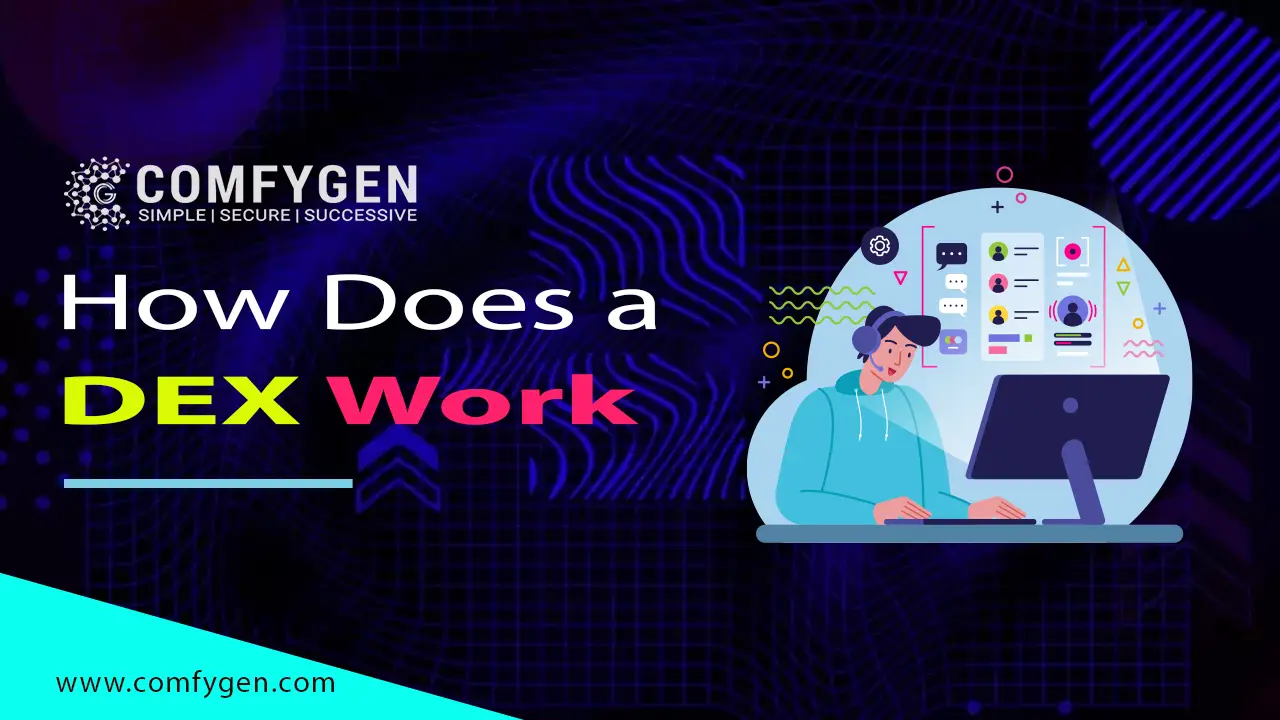
Smart contract-enabled blockchain networks are the foundation upon which decentralised exchanges are created. In essence, merchants utilise the DEX to communicate with blockchain smart contracts.
Automated market makers, order book DEXs, and DEX aggregators are the three primary categories of decentralised exchanges. Through their smart contracts, all of them let users conduct direct trades with each other. Similar order books to those used by centralised exchanges were utilised by the first decentralised exchanges.
Types of DEXs:
Decentralized exchanges (DEXs) can be divided into different types based on their underlying technology and functionality. Firstly, there are order book DEXs that operate similarly to traditional exchanges, matching buyers and sellers’ orders. These DEXs rely on smart contracts to facilitate trade execution and settle transactions. Secondly, there are automated market maker (AMM) DEXs, which use liquidity pools and algorithms to determine token prices based on supply and demand. Users can easily swap tokens directly from the pool, providing liquidity and earning fees. Thirdly, there are hybrid DEXs that combine the features of both order book and AMM models to optimize trading experience and liquidity. Apart from these, there are also layer 2 DEXs that utilize layer 2 scaling solutions like sidechains or plasma chains to enhance scalability. Each type of DEX offers unique advantages and caters to different trading preferences and requirements.
Automated market maker (AMM) DEXs:
A sort of decentralized exchange (DEX) protocol known as an automated market maker (AMM) uses a formula to determine the price of assets. Assets are valued using a pricing algorithm rather than an order book like a conventional exchange.
Order book-based DEXs:
Decentralised exchanges (DEXs) that operate on an order book allow users to purchase and sell cryptocurrencies. These purchases make up an order book that displays supply and demand in real time. Uniswap, SushiSwap, and PancakeSwap are a few examples. Users may control and transact directly from their wallets, providing transparency.
Key Features and Components of DEXs

Decentralized exchanges (DEXs) have several key features and components that distinguish them from centralized exchanges. Firstly, DEXs operate on blockchain technology and utilize smart contracts to facilitate transactions and automate settlement. This ensures transparency, immutability, and eliminates the need for intermediaries. Secondly, DEXs emphasize user control and security, as users retain ownership of their assets and hold the private keys to their wallets. This reduces the risk of hacks or mismanagement by intermediaries. Thirdly, DEXs promote privacy by allowing users to transact without disclosing personal information, protecting their identities and financial data. Additionally, DEXs offer trustless transactions, eliminating the need for central authority or intermediaries to execute trades. This enables direct peer-to-peer trading and mitigates counterparty risk. Moreover, DEXs prioritize liquidity and trading options, providing access to a wide range of digital assets. Finally, DEXs promote financial inclusion by enabling anyone with an internet connection and a compatible wallet to participate, regardless of their location or access to traditional financial infrastructure. Overall, the key features and components of DEXs include blockchain technology, smart contracts, user control, security, privacy, trustless transactions, liquidity, and accessibility.
Smart Contracts:
The issue of centralised exchanges being susceptible to hacking assaults and security breaches, which can result in the loss of user cash, is resolved by the DEX smart contract developed on Zeeve Track. Additionally, customers of centralised exchanges sometimes have to rely on the exchange operator to store and handle their assets, which might be a point of failure if the operator is dishonest or inept.
Liquidity pools:
Users can contribute their cryptocurrency assets to liquidity pools, which are decentralised finance (DeFi) methods, to support trade. By maintaining balanced asset ratios and offering liquidity, users of these pools might earn fees. This promotes more seamless trade and enables users to actively engage in the DeFi ecosystem.
Decentralized order matching:
Buy and sell orders are matched directly between users in a trading system known as decentralized order matching, which does not rely on a central exchange. It uses distributed ledger or blockchain technology to provide transparency, security, and autonomy when performing deals, doing away with the need for middlemen.
Challenges and Limitations of Decentralized Exchange (DEXs)
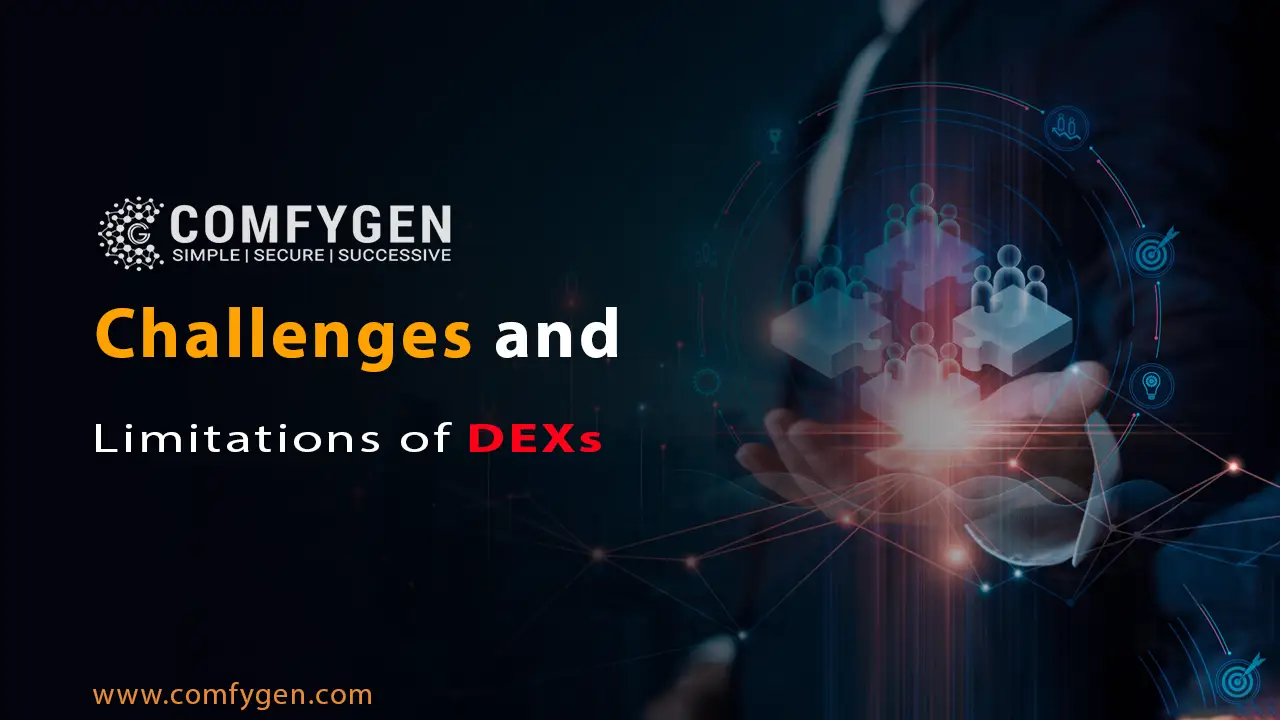
Regulatory and compliance concerns: According to a wide definition, regulatory compliance refers to an organization’s observance of the laws, rules, and regulations made by governmental legislation and regulatory agencies that are relevant to it based on the sector and region in which it works.
Regulations change a lot depending on the sector and the area. Large firms that operate internationally must abide by all applicable rules and regulations in each country.
Popular DEX Platforms and Examples
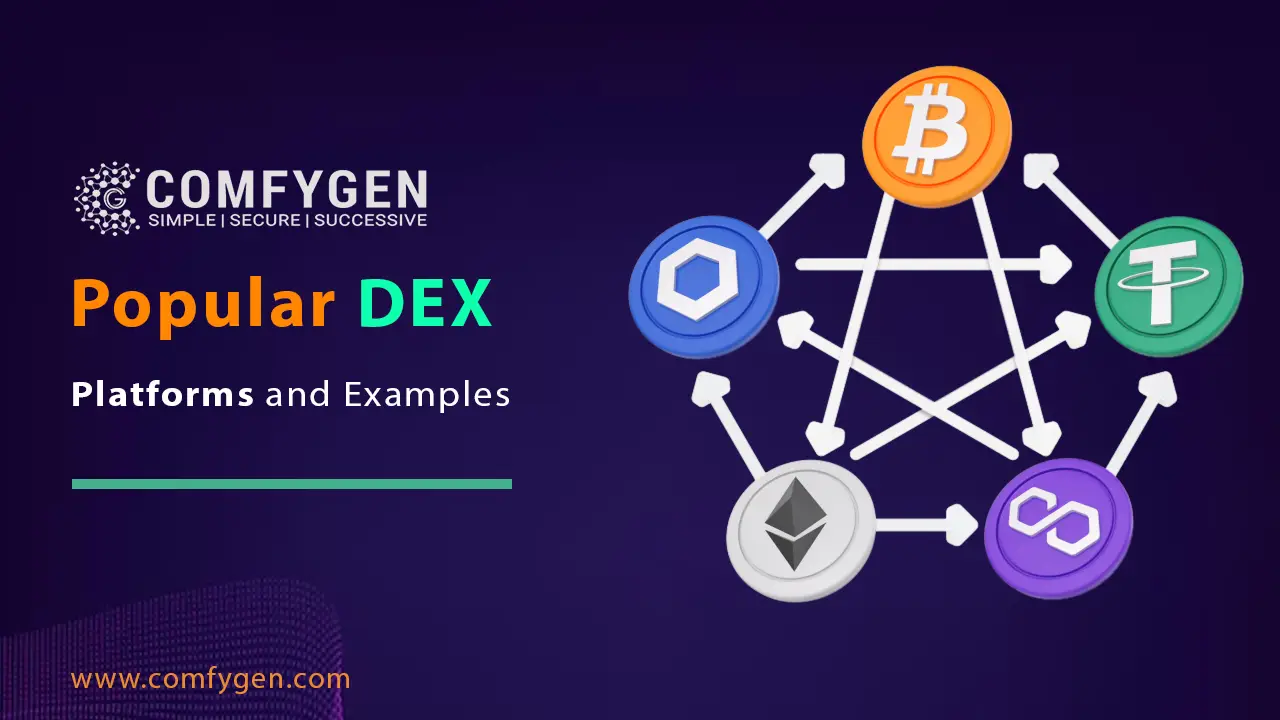
Several decentralized exchange (DEX) platforms have gained popularity in the crypto token space. One of the most well-known DEX platforms is Uniswap, built on the Ethereum blockchain. Uniswap utilizes an automated market maker (AMM) model and liquidity pools to enable token swaps. Another popular DEX is SushiSwap, which originated as a fork of Uniswap and offers additional features such as yield farming and staking. PancakeSwap is another prominent DEX that operates on the Binance Smart Chain, providing lower fees and faster transactions. Other notable DEX platforms include Curve Finance, which specializes in stablecoin trading, and 1inch, which aggregates liquidity from various DEXs to offer optimal trading routes. These are just a few examples of the many DEX platforms available, each with its own unique features and offerings.
Glance Here: Ethereum Development for Unlocking the Potential of Blockchain
Uniswap: On the Ethereum blockchain, Uniswap is a decentralized exchange system that enables users to trade different cryptocurrencies right from their wallets. Without depending on conventional order books, it employs an automated market maker system, liquidity pools, and smart contracts to enable permissionless and trustless token exchanges.
SushiSwap: A decentralized exchange (DEX) based on Ethereum is called SushiSwap. It removes the need for middlemen by allowing users to exchange various cryptocurrencies straight from their Cryptocurrency Wallet. It enables users to contribute funds and get rewards. It became well-known as a fork of Uniswap that included extra features like yield farming and governance tokens.
PancakeSwap: A decentralized exchange called PancakeSwap uses the Binance Smart Chain. Cryptocurrency trading by users creates liquidity for rewards. Compared to Ethereum-based platforms, it provides reduced costs.
Curve Finance: On the Ethereum blockchain, Curve Finance is a decentralized system geared at effective stablecoin trading. It provides low-slippage exchanges between assets of comparable value, like stable coins. For traders wishing to exchange reliable currencies with less loss, Curve’s design strives to offer a more safe and stable environment.
Future Outlook for DEXs

Potential growth and adoption:
The potential for a notion, technology, or idea to develop or be accepted by the market is referred to as potential growth and adoption. Increased innovation, user advantages, and integration are among them. Widespread usage and recognition indicate successful development and acceptance, which increases impact and importance in a particular environment.
Integration with layer 2 solutions:
By processing transactions off the main chain, integration with Layer 2 solutions boosts blockchain scalability and lowers costs. These approaches, like Optimistic Rollup for Ethereum, allow for quicker and more affordable transactions while still upholding the integrity of the underlying blockchain.
Conclusion of Decentralized Exchange (DEXs)
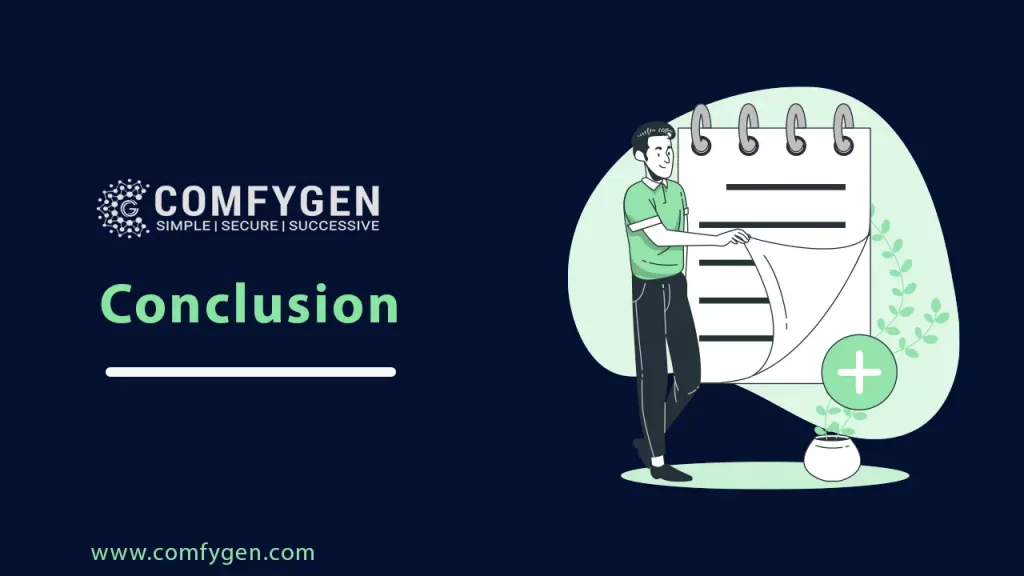
Decentralized Exchanges (DEXs) offer various advantages over centralized exchanges. The use of blockchain technology in DEXs ensures decentralization, reducing the need to rely on a centralized authority. This enhances security as users have control over their funds during trading, minimizing the risk of widespread hacking. Additionally, DEXs provide privacy by allowing users to trade without revealing their identities. The transparency offered by the blockchain ensures that every transaction is recorded, ensuring accountability. Moreover, some DEXs employ liquidity pools, enabling trading for less widely traded cryptocurrencies, enhancing liquidity in the market. Overall, DEXs provide a more secure, private, transparent, and liquid trading environment.